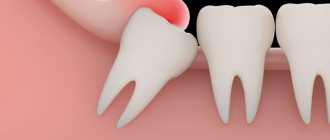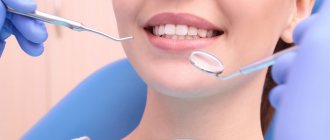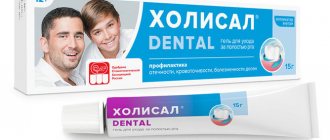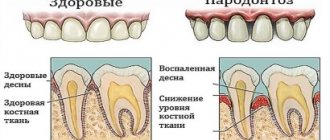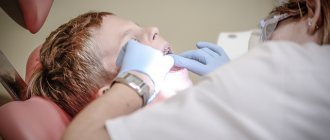What is periodontitis?
You need to know an enemy, and especially such a formidable one, by sight. Medical encyclopedias report:
“Periodontitis is an inflammatory disease of periodontal tissues.”
To the common man this definition will most likely seem incomprehensible. Therefore, in order to understand how insidious this dental disease is, it is worth remembering what periodontium is and its structure.
Periodontium is periodontal tissues whose main task is to hold the tooth in the socket.
Periodontium includes:
- Gums are soft tissues that surround part of the tooth root and protect it from external influences.
- Bone bed of the tooth or alveolar process. It consists of bone plates, and is penetrated by vessels and nerves.
- Periodontium is connective tissue that fills the space between the bone bed and the tooth itself.
- Cementum is the tissue that covers the root of the tooth.
So, periodontitis is a pathological process that affects all, without exception, periodontal structures. Beginning as inflammation of the gums, over time it spreads to the connective tissue and alveolar ridge. It is easy to guess that at a late stage the disease leads to loosening and loss of teeth. And the destruction of the ligamentous apparatus and bone bed makes the process of prosthetics impossible.
Stages of periodontitis
In its development, the disease successively passes through 2 stages:
- Initial . The patient periodically begins to notice blood on the toothbrush, sometimes feels itching and numbness in the gums. At this stage, the dentist diagnoses gingivitis - inflammation of the soft tissues.
- Developed . The gums become inflamed, bleed more often, and their contour begins to change. The patient is already uncomfortable drinking cold drinks and foods, and the general body temperature rises to low-grade fever. Over time, the situation only gets worse: teeth become loose, scattered, and later fall out.
If you seek help from a dentist, you can achieve a stage of stabilization or remission
periodontitis. This is not a complete cure, but only a subsidence of the inflammatory process.
A new exacerbation is possible even after a few months, or perhaps the patient will not remember about the problem for many years. It all depends on the timeliness of visiting a doctor and on how conscientiously his instructions will be followed.
The difference between periodontitis and periodontal disease
Very often, patients confuse periodontitis with a rarer, but no less insidious disease - periodontal disease. In both cases, we are talking about pathologies of the periodontium - the tissues that hold the tooth in the bone. But there is a huge difference between these two diagnoses.
- Periodontitis is an inflammatory disease that is widespread among the population. Periodontal disease can develop quickly and aggressively, making it possible to detect it in the early stages;
- Periodontal disease is not an inflammatory process, it is a systemic lesion of the periodontium, which leads to atrophy of the bone bed of the tooth. The disease is rare: no more than 2% of the population. Periodontal disease is characterized by a slow, asymptomatic course.
If the gums in the area of 1-2 teeth are affected, bleeding is present and swelling of the soft tissues is clearly visible, we can confidently speak of periodontitis. Periodontal disease always affects the entire oral cavity, and is detected in most cases very late, when the bone tissue has already severely atrophied.
Gastroprotectors – protection of the mucous membrane
Drugs of this pharmacological group are also included in the complex treatment of peptic ulcer disease. They create an enveloping protective shell on the surface of the mucous membrane of the intestines and stomach. The main active ingredient in most of them is bismuth salts: De-nol, Vikair, Vikalin, Sucralfate, Carbenoxolone, Misoprostol.
De-nol, in addition to creating a protective film on the ulcerative surface, promotes their scarring. Carbenoxolone is based on licorice root. It increases the viscosity of mucus, making it a reliable barrier between the walls of the stomach and duodenum and pepsins with hydrochloric acid.
It is perfectly excreted from the body through the intestines. Increased blood pressure is one of its serious side effects. Misoprostol is also a very effective remedy for peptic ulcers, despite its side effect of diarrhea.
Symptoms of periodontitis
The onset of periodontitis is almost invisible to the patient. Few people consider itching in the gums, minor discomfort during chewing and bad breath to be a good reason to visit a dentist. Patients begin to think about the need for treatment later: when the gums begin to bleed, react painfully to brushing their teeth, become inflamed and swell. If no action is taken at this stage, the teeth will soon begin to loosen. Advanced periodontitis can no longer be ignored. It is characterized by: increased body temperature, inability to chew due to sore gums, displacement and loss of teeth.
Causes of periodontitis
Dentists say the main culprit in the occurrence of periodontitis is bacterial plaque. If you do not remove it from the surface of your teeth in time, over time it hardens and turns into tartar. It, in turn, contributes to the formation of a gap between the gum and tooth, which is commonly called a periodontal or periodontal pocket. As a result, it becomes increasingly difficult to maintain oral hygiene: food debris gets clogged into the resulting gap and provokes an inflammatory process.
The rapid formation of tartar is not necessarily a sign of poor hygiene. The cause of the pathological process may be reduced secretion of saliva, which naturally cleanses the oral cavity. This problem often occurs during long-term use of antidepressants and anti-inflammatory drugs.
The disease can also develop due to a lack of vitamins and microelements. Thus, a lack of calcium will certainly affect the entire skeletal system of the body, and a deficiency of vitamin C reduces the strength of connective tissue. In adults, periodontitis can be a payback for the habit of chewing on one side and a dislike for solid foods: raw vegetables and fruits - ideally, the load on the teeth should be even, and the gums need daily training.
Antioxidant treatment
Among this group of drugs, the most famous are the following:
- Mexidol. It is a modern antioxidant drug that effectively eliminates periodontitis. Taking this medicine can significantly reduce the treatment time for the disease. If the dosage is correctly chosen, the positive effect becomes noticeable after two weeks.
Mexidol not only has a detrimental effect on bacteria, but also promotes the rapid restoration of the immune system, normalizes cell metabolism and prevents the spread of infection. This drug is recommended by experts for the treatment of not only periodontitis, but also any other inflammatory diseases of the oral cavity.
- Carotenoles. A very new drug that has already gained significant recognition among dentists. Helps restore immunity by attacking bacteria.
Treatment of periodontitis in dentistry
Periodontitis is an insidious disease: it never heals spontaneously. But you just need to start the process a little, and you can no longer talk about a complete cure, but only about going into remission. Therefore, at the first symptoms of gum inflammation, it is worth carving out a few hours from your busy work schedule and contacting an experienced dentist.
Modern medicine is not at all helpless in the face of illness. Doctors have a variety of conservative, hardware and surgical methods of treating periodontal disease in their arsenal. Which one will be most effective in each specific case can only be determined by a specialist.
Surgical intervention
The main criterion for the need for surgical intervention is an increase in the depth of the periodontal pocket and obvious progression of the inflammatory process, despite drug therapy.
There are several methods of surgical treatment of periodontitis. All of them are aimed at stopping the pathological process, eliminating periodontal canals, and preventing the patient from losing teeth.
Open curettage or flap surgery. Allows you to clean the deepest periodontal pockets, and is performed under local anesthesia. To reach the affected areas, the doctor makes an incision and peels away the gum. And then, using hand tools or using ultrasonic devices, he carries out a thorough cleaning. After this, the cavity of the pockets is filled with osteogenic preparations, and a suture is placed on the gum.
Gingivectomy. This is an operation to remove the excess edge of the gum when it grows excessively. Its goal is to eliminate periodontal pockets in order to prevent the spread of the process from soft tissues to the ligamentous apparatus and bone bed of the tooth. It is performed either under local or general anesthesia.
Splinting. It involves installing a removable or non-removable splint on the inner surface of the teeth, the task of which is to fix the teeth in the correct position and prevent them from moving. This procedure allows you to save teeth even with advanced periodontitis and severe loosening.
If the cause of periodontitis is a malocclusion or a shortened frenulum, the first thing a specialist will do is correct the anatomical disorders. And there are no age restrictions for this.
100% discount on periodontist appointments!
Moscow
Laser treatment
Very often, surgical treatment of periodontitis is supplemented or replaced by a laser curettage procedure. This is a bloodless, minimally invasive method that requires local anesthesia only in patients with a low pain threshold.
In Western Europe, laser curettage has been used for the treatment of periodontitis for about 15 years. Experience has shown that the method is effective for all forms of the disease and guarantees a stable, long-term effect.
During the procedure, the doctor applies a photosensitizer gel to the gums. Then the light guide of the device is inserted deep into the affected periodontal pocket. The next step is to activate the gel with a thin laser beam, which instantly coagulates the infected tissue. Moreover, only pathogenic flora is subject to destruction; neither the laser nor the photosensitizer has any effect on healthy areas of the gums.
The result of laser treatment of periodontitis is complete sterilization of periodontal pockets, on the walls of which a protective photocoagulation film is formed immediately after the procedure. It prevents the penetration of pathogenic bacteria between the gum and tooth, and promotes the rapid closure of the periodontal pocket.
The duration of the laser curettage procedure is no more than 3 minutes. If the disease is detected at an early stage, the affected areas can be completely cured in just one visit to the dentist. In advanced cases, 2 or more procedures may be required, which are carried out with a break of 1 week.
Ultrasound treatment
At the initial stage of development of periodontitis, gum inflammation can be eliminated by simply removing tartar. This type of teeth cleaning is called scaling and is carried out using ultrasonic instruments. One of the most common is the Vector device, developed by the German company Durr Dental.
Unlike traditional scaling, Vector deals with deposits painlessly for the patient. Under high pressure, the device delivers a Fluid Polish polishing suspension to the treated area, which destroys the biofilm on the tooth surface without affecting the root cement and without injuring the soft tissue. This delicate approach allows not only to shorten the treatment period for periodontal disease, but also to avoid the use of antibiotics.
Vector therapy is indicated for patients with any stage of periodontitis. At an early stage, the method leads to complete cure. In more advanced cases, ultrasound scaling precedes surgical treatment.
How to treat periodontitis correctly:
Treatment of periodontitis will depend primarily on the severity of the inflammatory process in a particular patient. The more significant the level of bone loss and the degree of tooth mobility, and the more missing teeth you have, the more difficult, time-consuming and expensive the treatment will be. It all starts with a consultation, and you should not go to a regular dental therapist, but only to a periodontist (this is a doctor who specializes in the treatment of gum inflammation).
The author of this article has worked as a periodontist for more than 10 years, and therefore all our recommendations, which you will see below, really work (state-issued documents on advanced training in the Periodontology program can be viewed in the editorial section).
Consultation with a periodontist –
The first thing to do is make a treatment plan. This is not as easy to do as it might seem in reality. If the disease is mild, you may only need to consult a periodontist. However, in case of mobility and divergence of teeth, malocclusion, when there are already missing teeth or those that will definitely have to be removed, a joint consultation with an orthopedic dentist (prosthetist) is necessary.
X-ray diagnostics – for a full consultation, a panoramic X-ray will be required to assess the level of bone tissue destruction, location and depth of periodontal pockets. The image will allow you to make the correct diagnosis, which will include the severity of your disease. For the patient (whose panoramic image is shown below), the diagnosis will be as follows: “Chronic generalized severe periodontitis.”
Pay attention to the photo. You can notice that the level of bone tissue (looks like light, finely looped cellular tissue in the picture) is reduced in some teeth by 2/3 of the root length, and in a small number of teeth - only by 1/4. The patient has roots that need to be removed, as well as caries that requires treatment. It is especially noticeable that the bone level is maximally reduced in the front teeth of the upper and lower jaws, which is also due to their chewing overload (due to the absence of a large number of lateral teeth).
In similar situations, if a decision is made to preserve the front teeth, it is necessary to make a temporary removable denture as quickly as possible. It will replace missing teeth and relieve increased chewing load from the front teeth.
Removal of supra- and subgingival dental plaque –
The cause of periodontitis is soft microbial plaque, as well as supra- and subgingival dental plaque. Treatment cannot be effective without removing the causative factor, and therefore the basis of treatment for inflammatory gum diseases is high-quality removal of dental plaque. There are 2 main techniques that can be used in patients with periodontitis:
- ultrasonic teeth cleaning,
- Vector system.
How ultrasonic teeth cleaning is carried out (video) –
There are fundamental differences between ultrasonic scalers and the Vector system, but we do not want to overload this article with unnecessary information (therefore, you can read more about the Vector system at the link above). The only thing worth adding here is that at the 1st stage of treatment, in any case, you need to use only the classical ultrasound technique. And so to speak, “polishing the result” can be done in about 4-6 weeks using a Vector-Paro device, but it will cost 3-4 times more than conventional ultrasonic cleaning.
Important: in patients with periodontitis, it is simply impossible to remove all dental plaque in just 1 visit, and it is usually necessary to make appointments with patients several times. This is due to the fact that searching for and removing subgingival dental plaque requires a lot of time. In addition, the patient comes to the second appointment with less swollen and inflamed gums, which leads to a decrease in its volume, as well as, to a small extent, the depth of periodontal pockets. Accordingly, thanks to this, we will be able to look deeper on the 2nd visit and see subgingival tartar, which we had not previously noticed and missed.
In addition, it is important not only to remove subgingival tartar, but also, if possible, to polish the exposed surface of the tooth roots in the depths of periodontal pockets. The latter is done by careful movements of the ultrasonic tip nozzle, using special nozzles at low power. Otherwise, the rough surface of the root will contribute to the rapid formation of a new portion of subgingival tartar. In general, removing plaque from periodontitis is not easy, it is not quick, and it requires the patience and perseverance of a doctor, and by definition, this cannot be cheap. It will be cheap only if you remove the tartar “quickly”.
Anti-inflammatory therapy for periodontitis –
The course of anti-inflammatory therapy for periodontitis usually lasts 10 days. It is prescribed by a periodontist immediately after the 1st session of removing dental plaque. The course will necessarily include medications for local use in the oral cavity - these are antiseptic rinses and anti-inflammatory gel for the gums, which the patient will use at home. In addition, if there is purulent or serous-purulent discharge from periodontal pockets, antibiotics are prescribed internally.
ANTI-INFLAMMATORY THERAPY SCHEME:
It is prescribed by a dentist, and carrying out such anti-inflammatory treatment of periodontitis on your own is not at all difficult. The standard course of treatment lasts only 10 days. Treatment of gums should be carried out by the patient 2 times a day - morning and evening. It looks like this... In the morning, treatment is carried out after breakfast and oral hygiene (it is important - breakfast first, and only then brushing your teeth, and not vice versa). Likewise in the evening - first dinner, then brushing your teeth, and only then are antiseptic rinses and applications of gel to the gums.
So, after breakfast/dinner and oral hygiene, you must first perform an antiseptic mouth rinse with a 0.2% chlorhexidine solution (we will tell you why the standard 0.05% solution is not very effective for these purposes). To do this, you must take approximately 10 ml of solution into your mouth, which is 1 average sip. And then, without spitting anything, you should rinse your mouth for exactly 1 minute. Important: after an antiseptic rinse, you should not rinse your mouth with water.
Applying gel to the gums – the second stage of treatment is applying an anti-inflammatory gel to the gums. Over the 10 years of working as a periodontist, I have tried many different drugs, but I responsibly declare that Cholisal gel works best. An important point - before applying the gel to the gums, it is advisable to dry them with a dry gauze swab (it can be made from a bandage), because Any gel will adhere better to the dried mucous membrane.
The application of the gel to the gum is carried out in front of a mirror, and you must grin so that during the procedure you can see the edge of the gum and where exactly you are applying the gel. The gel must be applied with your finger - precisely on that part of the gums that is located around the necks of the teeth (gingival margin), and this must be done not only from the front surface of the dentition, but also from the palate / tongue. Now let's look at how exactly you need to apply the gel to the den.
If we are talking about treating the gums from the front surface of the teeth, then it is better to do it in two stages. First, you squeeze a little gel onto your finger several times and rub it into the gum margin with light massaging movements. Then squeeze the gel onto your finger again, and then apply it to the gum edge, without rubbing. As for the treatment of the gums from the side of the tongue/palate, it can be done once - only by rubbing small portions of the gel with light massaging movements.
Important: saliva will always be released during the application of the gel, and there is no need to accumulate it or spit it out. You must swallow it - as you usually do. In addition, after applying the gel to the gums, it is advisable not to drink anything for 30-60 minutes, and also not to eat or rinse your mouth for 2-3 hours. The second treatment of the day is carried out in the evening according to a similar scheme (dinner → brushing teeth → antiseptic rinse → gel application). And so on for 10 days.
An important question regarding the concentration of chlorhexidine is
There are clinical studies (source) that show the comparative effectiveness of different types of antiseptics and their different concentrations in the treatment of chronic generalized periodontitis. The fact is that in most patients with periodontitis, not only pathogenic bacteria live in periodontal pockets, but also fungal flora. The presence of fungal flora in periodontal pockets has a very important impact on the effectiveness of anti-inflammatory gum therapy in general.
Despite the fact that gum inflammation during periodontitis is caused directly by pathogenic bacteria, the presence of fungal flora makes these bacteria less sensitive to antiseptics and antibiotics. Accordingly, this requires the use of higher concentrations of antiseptics and antibiotics, which must be effective against both bacterial and fungal microflora. Only 2 antiseptics have these properties - either 0.2% chlorhexidine or 0.1% hexetidine (0.1% Hexoral solution).
Examples of great mouthwashes are:
Important: most often, concomitant fungal flora with periodontitis occurs in the following categories of patients. For example, if your gum inflammation is long-term, chronic, or you smoke, or eat a lot of carbohydrates, or have concomitant chronic tonsillitis, or you have gastrointestinal diseases, or you have had at least 1 case of candidiasis in the past ( thrush) of any localization.
In all these cases, you should not use 0.05% chlorhexidine to rinse your mouth with periodontitis, but rather purchase a 0.2-0.25% chlorhexidine solution (in such concentrations it is highly effective, including against fungi of the genus Candida). Such concentrations of chlorhexidine are contained in rinses - Parodontax Extra, Lacalut Activ and PresiDent Professional. For more information about choosing agents for the treatment of periodontitis, read the articles at the links below.
→ The best mouth rinses for periodontitis, → Rating of the best gels for gums.
Systemic antibiotic therapy –
If you have periodontitis, you can’t just take and start drinking any antibiotic, because... it is necessary to take into account the nature of the microflora in periodontal pockets. There are 2 options here: either prescribe a broad-spectrum antibiotic, or first culture the contents of the periodontal pocket for microflora. However, culture is always recommended for patients with aggressive periodontitis and vertical type of bone resorption. For more information about the choice of antibiotics and their dosage regimens, read the article:
→ Choice of antibiotics for gum diseases
Sanitation of the oral cavity and depulpation of teeth –
In parallel with the removal of dental plaque and anti-inflammatory therapy, it is necessary to begin treatment of carious teeth and removal of decayed teeth. At this stage, temporary splinting of mobile teeth can be carried out, as well as restoration of missing teeth with a temporary removable denture (to urgently relieve the mobile teeth). In addition, a very important point is the need for tooth depulpation.
For example, it is necessary to remove nerves from teeth with deep periodontal pockets (having a depth of more than 1/2 the length of the root). It is ideal when, before filling the root canals in these teeth, the “copper-calcium depophoresis” technique is also performed, but it is advisable to do such a procedure only in those teeth that have mobility. This allows you to disinfect all microscopic branches of the root canals inhabited by pathogenic bacteria. The combination of “depulp removal + depophoresis” can significantly reduce tooth mobility (provided that the traumatic bite is also neutralized).
Everything we said above is only basic treatment. Depending on the specific clinical situation in the oral cavity, other methods of treating periodontitis may be used. This may include splinting mobile teeth with fiberglass, surgical techniques (curettage and flap operations), the manufacture of temporary and permanent dentures, as well as selective grinding of teeth.
Splinting for periodontitis –
Splinting of mobile teeth is usually carried out in the presence of their mobility. This technique allows you to strengthen your teeth, quickly reduce inflammation, and also stop the progression of bone tissue destruction around these teeth. Splinting can be temporary or permanent, and can be done using fiberglass or artificial crowns “soldered” together. In Fig. 12-14 you can see the beginning of the splinting process, and the fiberglass tape laid on the lingual surface of the lower teeth (later it will be covered with a light composite).
Read about the features of this method and its cost in the article: → Splinting of mobile teeth for periodontitis
Surgical treatment of periodontitis –
It must be said that this is one of the most important methods used in the complex therapy of periodontitis, the use of which can really stop the progression of this disease. There are several methods of surgical treatment, which include open curettage, as well as flap operations. The purpose of surgical intervention is to remove all dental plaque from under the gums, clean out all inflammatory granulations (which form at the site of destroyed bone tissue), and ultimately eliminate periodontal pockets.
Such operations are performed by dental surgeons specializing in periodontics. The operations are complex and require diligence and skill from the doctor, so there are very few good specialists in this field. In Fig. 15-16 you can see a fragment of the open curettage operation. The gum is detached from the teeth, the edge of the bone tissue is slightly exposed, the inflammatory granulations have already been cleaned out, but the deep periodontal pocket in the canine area is clearly visible (which in the second photo is filled with osteoplastic material, which will partially restore the bone level).
Read more about this treatment method in our article: → Curettage for periodontitis
Prosthetics for periodontitis –
Orthopedic treatment of periodontitis is carried out in those patients who have missing teeth, or the method of splinting mobile teeth using artificial crowns has been chosen. This stage of treatment is essentially the final one (not counting subsequent periodic maintenance therapy), and the prognosis of the teeth will largely depend on it. The goal of the orthopedic stage of treatment is to restore the chewing efficiency of the dentition, reduce the chewing load on weakened teeth, thereby preventing displacement, protrusion or fan-shaped divergence of teeth.
As we said above, prosthetics can be temporary or permanent. Temporary prosthetics with a removable denture are necessary when a large group of teeth is missing. Such a prosthesis will reduce the load on the remaining teeth, increase the effectiveness of anti-inflammatory therapy, reduce tooth mobility, and also stop bone destruction. In addition, if curettage or flap surgery is planned, then ignoring the need for temporary prosthetics in such a situation can only lead to an increase in tooth mobility, as well as to stimulation of horizontal bone resorption in the operation area.
Treatment with medications at home
Treatment of periodontitis is always complex. But if surgical methods are not indicated for everyone and not always, and they are increasingly being replaced by hardware procedures, then drug therapy is a mandatory element of treatment. It includes the following:
- antiseptics;
- steroidal and non-steroidal anti-inflammatory drugs;
- immunomodulatory agents.
It is impossible to cope with periodontitis on your own at home! No miraculous toothpastes, magic toothbrushes or even injections will help if you do not eliminate the main cause of inflammation - bacterial plaque and tartar. Therefore, the medicinal method of treating periodontitis will bear fruit only after the dentist has cleaned the teeth, and, if necessary, undergone surgical intervention.
In almost all cases, dentists insist on treating periodontitis with antibiotics. They can be local, in the form of ointments or gels. But more often, broad-spectrum drugs are prescribed: Trichopolum, Doxycycline, Metronidazole. It is recommended to take them in the form of tablets; less often, the dentist may recommend injections.
Treatment with folk remedies
Methods known to our grandmothers help strengthen the gums and relieve inflammation, especially at the initial stage of the disease.
The main thing to remember: alternative treatment must be agreed with the attending physician and carried out under his supervision.
The most effective means for treating gums are:
- Massage the gums using circular movements of the pads of the thumbs. You need to do it in the morning and evening for 5-10 minutes. To make the effect more noticeable, simultaneously with the massage, it is worth rubbing honey, sea buckthorn or fir oil into the soft periodontal tissues.
- Rinse. They are performed immediately after brushing your teeth with comfortable-temperature decoctions and tinctures diluted with water. To make them, they use calendula flowers, oak bark, string, celandine and pine needles.
- Applications. For them you can use honey, beeswax, sea buckthorn oil, Kalanchoe juice.
The use of antacids in the treatment of ulcerative lesions
Stomach and duodenal ulcers are a serious disease
The tradition of using drugs in this group goes back more than one decade. Their therapeutic effect is based on the chemical reaction of gastric juice with the reagents that make up antacids. Thanks to this, its aggressive effect on the walls of the stomach and intestines is reduced.
Such reagents are magnesium and aluminum hydroxides, like Maalox and Almagel, or aluminum phosphate, like Phosphalugel. They differ significantly from obsolete soda-based preparations; they envelop the walls of the stomach without being absorbed into them. Antacids can adsorb pepsin, the acidity of which decreases sharply when exposed to them.
Is it possible to restore gums?
Periodontitis is a disease that greatly impairs the aesthetics of a smile. That is why dentistry has long and successfully used a surgical method of gum restoration - gingivoplasty. With its help, you can change the height of the gum, improve its structural condition, restore atrophied tissue or, conversely, remove excess.
Contraindications to the operation are: diabetes mellitus, cancer, decreased blood clotting, and inability to use anesthesia.
In other cases, after carrying out anti-inflammatory procedures and achieving stable remission, you can safely start a conversation with your doctor about gingivoplasty.
Types of periodontitis
To select an effective treatment, the dentist must first determine the causes of periodontitis and identify the nature of the disease. Therefore, the classification of periodontitis is not so much of scientific interest as it contains the ability to predict the further development of the situation and select those treatment methods that will give the best result.
One or another type of periodontitis can be diagnosed based on 3 criteria: severity, course of the disease and localization of the process.
By severity
To determine the severity of the disease, dentists evaluate the depth of the periodontal pocket, tooth mobility and the degree of bone tissue resorption:
- with mild periodontitis,
the teeth are immobile, the depth of the periodontal canal does not exceed 3.5 millimeters. The height of the interdental septa is still slightly reduced: no more than one third of its length; - with moderate periodontitis,
the height of the interdental septa is reduced by half its length, the periodontal pockets deepen to 5 millimeters, and the teeth begin to slowly shift; - Severe periodontitis
is visible to the naked eye even when talking to a person. The teeth are displaced and gaps form between them. And the patient complains of severe pain, bleeding, and sometimes the discharge of pus from the periodontal canals.
Severe periodontitis is statistically observed in 15-20% of people over 35 years of age.
With the flow
The course of the disease can be acute or chronic. The acute form of periodontitis is very rare and does not affect the entire oral cavity, but a small area of the gums. It occurs as a result of injury to soft tissues as a result of an impact, an incorrectly installed crown, or a broken piece of tooth.
Acute periodontitis develops at lightning speed and causes severe pain, with which the patient usually rushes to the dentist. The chronic process is characterized by a wave-like course and coverage of the entire oral cavity. When the disease enters the remission stage, the patient mistakenly believes that he is completely cured. But after a few months everything repeats itself, and this time the signs of inflammation will be more pronounced.
With timely consultation with a doctor, acute periodontitis can be cured quickly and effectively. If periodontitis has entered the chronic stage, the prognosis is less favorable.
By localization
Depending on how extensive the area is covered by the pathological process, periodontitis is distinguished:
- localized
or
focal
; - generalized
.
In the first case, the disease manifests itself in only one or several teeth. And dentists talk about the activation of secondary factors. This means that the development of periodontitis could be triggered by a poor-quality filling, contact with arsenic paste or filling material on the gums, careless installation of a prosthesis, and even injury to the gums by dental floss.
In the generalized form of periodontitis, the gums, connective and bone tissue on two rows of teeth are affected. This is typical for the chronic course of the disease, which is much more difficult to treat.
Treatment with leeches
Hirudotherapy is also very effective for dental diseases, including periodontitis. The action of leech secretion is effective in fighting infection, which often provokes the development of this disease, and also stimulates the body’s protective functions, forming a powerful immune system. Treatment of periodontitis in this way begins with treating the gums with antiseptic solutions. After this, 1-2 leeches are placed in the area of the transitional fold of the gum in the projection of the apex of the tooth root for 5-10 minutes. The course of treatment, depending on the extent of the inflammatory process, is 1-5 procedures daily or every other day.
Hirudotherapy is contraindicated for:
- pregnancy
- hemophilia
- severe anemia
- hemorrhagic diathesis
- persistent hypotension
- oncological diseases
- individual intolerance
Diagnosis of the disease
The main diagnostic method for suspected periodontal disease is measuring the depth of the gap between the gum and tooth. In a healthy person it does not exceed 1-2 millimeters. The procedure is carried out using a periodontal probe, a thin instrument with millimeter notches.
If the process is generalized, the doctor measures the periodontal pockets of each tooth, records the obtained indicators and draws up a periodontogram. In the future, it will make it possible to evaluate the effectiveness of treatment or, conversely, to detect the progression of the disease in time.
X-ray examination is important for diagnosing periodontitis: panoramic X-ray or layer-by-layer scanning. It allows you to identify loss of bone tissue and its sclerotic changes.
In very severe cases, the doctor may refer the patient for further examination: measure the degree of hypoxia in the gums, determine the quality of the periodontal microvasculature, examine bone tissue for density.
Prevention of periodontitis
The best prevention of periodontitis is proper oral care. You need to brush your teeth at least 2 times a day: before breakfast and before bed. Moreover, the procedure should take at least 3 minutes, and the main movement when cleaning is from the root to the cutting edge of the tooth. Don't ignore dental floss. They perfectly clean the interdental spaces and prevent the development of pathogenic bacteria.
If the disease has already manifested itself, pay attention to your toothbrush. Her stubble should be stiff. And even if at first brushing your teeth with its help seems uncomfortable, over time your gums will get used to it. You need to change your toothbrush every 1.5 months.
Author: Maria Kozodaeva Candidate of Medical Sciences. Dentist-therapist, endodontist, periodontist, implant surgeon. Work experience more than 11 years.
The information is for reference only. Before treatment, consultation with a doctor is necessary.
Antibacterial agents against Helicobacter pylori
One of the tests prescribed by your doctor may be a blood test for antibodies to Helicobacter pylori. And this is not accidental, since according to data from various sources, it is this bacterium that is resistant to hydrochloric acid that in the vast majority of cases is the cause of peptic ulcer disease.
Medicines for stomach and duodenal ulcers: De-Nol
If this bacterium is not eliminated, regardless of the effectiveness of the drugs used to treat the ulcer, the risk of relapse of the disease and a decrease in periods of remission are very high. There are several treatment regimens for such bacterial infection, the main drugs in which are antibiotics of the nitroimiazoline group - Tinidazole, Metronidazole, Tetracycline.
Since these drugs have been on the drug market for a long time, their effectiveness is increasingly being questioned. This is due to the increased resistance of bacterial strains to this group of antibiotics. They were replaced by more modern antibiotics from the macrolide group. They have many advantages, and significantly fewer side effects and contraindications.
We must not forget about the extremely aggressive environment in which antibiotics have to “work” in the gastrointestinal tract. They must resist the effects of hydrochloric acid, the production of which increases significantly during peptic ulcer disease. The most stable antibiotic in this group is Clarithromycin. It is used in combination with other drugs in a dosage of 0.5 g twice a day.


